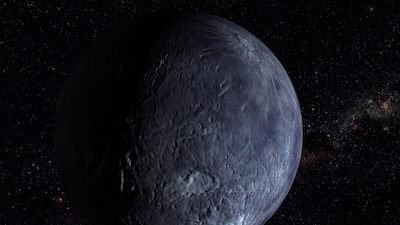
The Planet That Should Be Dead
Space.com: “Pluto’s Moon is an Ice Machine”
Although Pluto is no longer classified as a planet, it is still generating headlines, or, rather, its moon, Charon, is causing some astronomers to take notice. Many secular researchers consider the Kuiper Belt Objects (of which Pluto-Charon are a part) to be primordial leftovers of the formation of the Solar System about 5 billion years ago. They are cold, distant objects (many binary) that seemed to have very little reason to be geologically active. After all, planets and moons usually generate heat when radioactive elements break down over time (some, on the other hand, can also generate heat from tidal forces, which are not the cause here); thus, there is only a limited “fuel supply” that can keep the object active. In most cases, the smaller the object is, the less fuel that’s available. The less fuel that’s available, the less time it can be active.
The less fuel that’s available, the less time it can be active.
From a biblical standpoint of a six-thousand-year-old creation, most objects in the Solar System could very well be active with plenty of “power” left in the core. However, the big bang model with its ancient universe has much more difficulty explaining why moons that should have run out of fuel are still active—even when relying upon uniformitarian assumptions about radioactivity (for more information, see Enceladus: A Cold, Youthful Moon).
On that point, this tiny moon never knew about the big bang model. An article on Space.com states:
Slushy geysers on Pluto’s moon Charon apparently coat the tiny world in ice crystals, making it something like the outer solar system’s equivalent of an ice machine.
[...]
There are no photos of the geysers or the ice. Instead, astronomers learned of the ice deposits after discovering the spectral fingerprints of ammonia hydrates and water crystals in light coming from the moon. The findings suggest that ammonia-laced liquid water from deep inside Charon is seeping out through cracks onto the moon's frigid surface.
Obviously, very little can be gleaned from the indistinct glimpses we have of the distant moon, and, as the article states, NASA’s New Horizons space probe will be able to verify these observations when it arrives in 2015. But for the time being, it is interesting to note that while the astronomers recognize that the most feasible explanation for the possible geysers is “heat from radioactive materials in Charon’s interior,” they are strangely silent on how such materials could still be there in appreciable amounts in such a tiny moon after billions of years.
Remember, if you see a news story that might merit some attention, let us know about it! (Note: if the story originates from the Associated Press, Fox News, MSNBC, the New York Times, or another major national media outlet, we will most likely have already heard about it.) And thanks to all of our readers who have submitted great news tips to us.
(Please note that links will take you directly to the source. Answers in Genesis is not responsible for content on the websites to which we refer. For more information, please see our Privacy Policy.)
Recommended Resources

Answers in Genesis is an apologetics ministry, dedicated to helping Christians defend their faith and proclaim the good news of Jesus Christ.
- Customer Service 800.778.3390
- © 2024 Answers in Genesis







